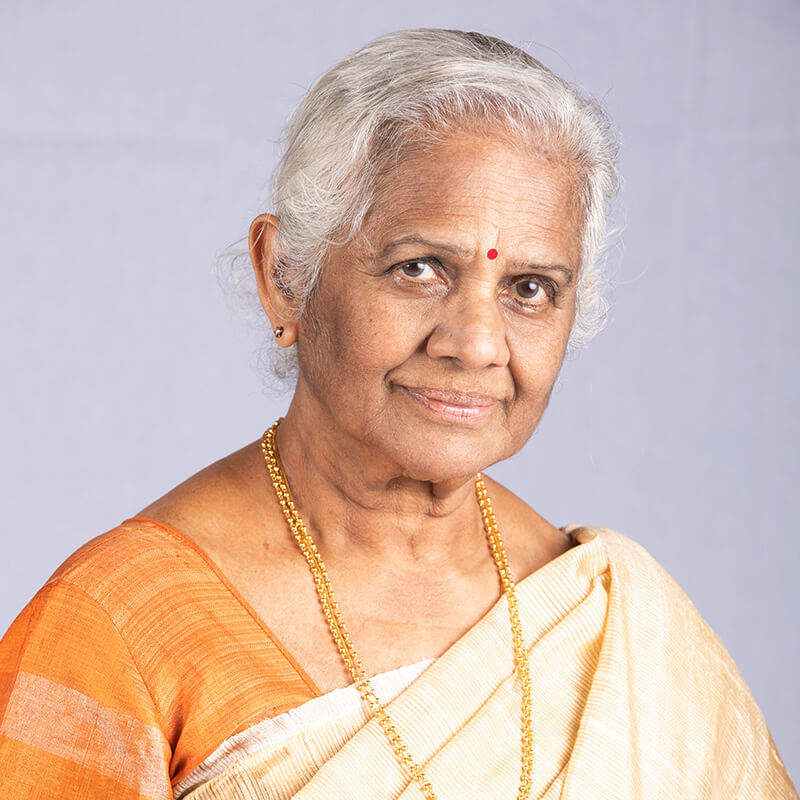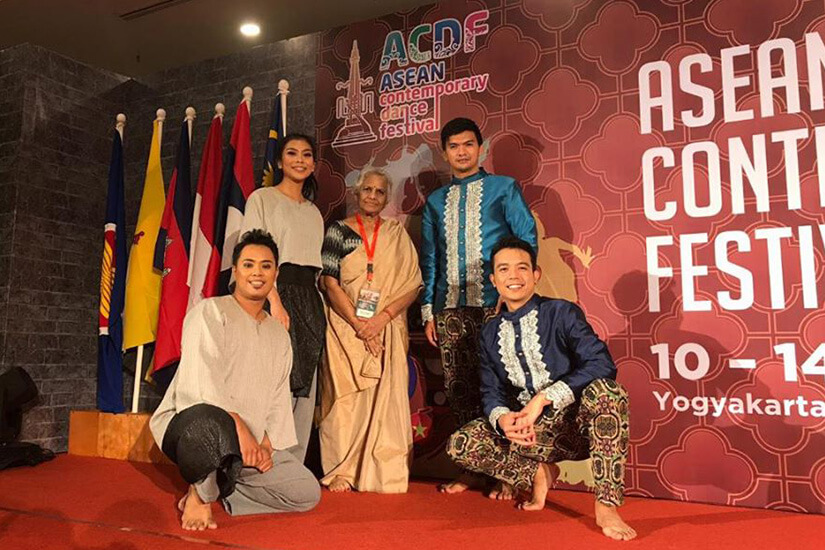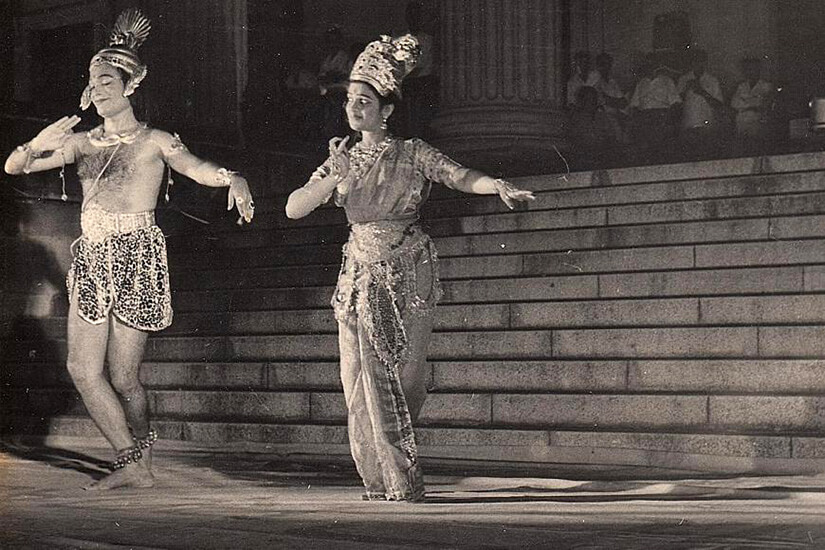
BORN
1939
INDUCTED
2021
CATEGORY
Arts & Culture

THE HONOURED INDUCTEES TO THE SINGAPORE WOMEN’S HALL OF FAME
SANTHA BHASKAR
Pioneering dancer and choreographer
As a child in India, Santha Bhaskar was much more interested in science and mathematics than in classical Indian music and dance. But her family was steeped in the arts, and her father encouraged her to concentrate on Indian dance, which led to her coming, in 1955, to Singapore and making her mark as a pioneering dancer and choreographer.
Born in Kerala, India, in 1939, Santha was exposed to classical Indian music and dance at an early age. At school she excelled at science and mathematics but, guided by her father, she also diligently continued her study of music and dance. She was trained in the Indian dance traditions of Mohiniyattam, Kathakali and Bharatanatyam by masters such as Ramunni Panicker, Guru Kunchu Kurup and Kutralam Ganesam Pillai.
Santha expected to pursue her studies at university level, but when she was 16, her parents arranged for her to marry K P Bhaskar, a classical Indian dancer and dance instructor who was 14 years older than her. In 1952, Mr Bhaskar had moved from Kerala to Singapore where he established Bhaskar’s Academy of Dance (known as Bhaskar’s Arts Academy since 1993), one of the first Indian dance schools in Singapore. In 1955 Mr Bhaskar returned to Kerala to find a bride who could dance.
Coming to Singapore, Santha once said, was her destiny: “It was divinely decided that I was to serve here, and I am very happy about it. I came to Singapore and saw the beauty of other cultures, I absorbed all of that and naturally my dance and choreography styles reflected that.”
As the Artistic Director and Chief Choreographer at the Dance Academy, a position she continues to hold, Santha looked for ways to inject elements of other Asian dance styles into her choreographic work. It helped that the Bhaskars lived initially in Joo Chiat where a neighbour was Zubir Said, the composer of Singapore’s national anthem. Mr Zubir sometimes composed music for their performances.
In 1958, Santha and her husband watched the Chinese movie The Butterfly Lovers. Based on a classical Chinese folk tale, the film is about a pair of star-crossed lovers. At that time, there were many Chinese students learning Indian dance at their Academy. So, the Bhaskars decided to turn the story into a dance drama.
The Bhaskars’ The Butterfly Lovers production weaved together elements of traditional Indian and Chinese dance, with the choreography being performed to Tamil lyrics. The costumes also reflected a combination of Indian and Chinese influences. It was Santha’s first experimental, cross-cultural work. Santha was then 19 years old, and she had just given birth to the first of her three children.
During the early 1960s, Bhaskar’s Academy of Dance regularly took part in Aneka Ragam Rakyat (People’s Cultural Concerts), the multi-cultural shows that were staged across Singapore in the effort to get people to better understand and appreciate the culture of the various ethnic communities.
In 1968, Santha was the Indian dancer featured in a series of stamps issued by Singapore Post Office to reflect Singapore’s multiracial and multicultural society.
In 1977, Santha began to tutor a small group of undergraduates in Indian dance at NUS’ Centre for Musical Activities (now known as the NUS Centre for the Arts). Forty-two years later, she continues to teach at NUS, and is its longest serving arts tutor. NUS Indian Dance was established under her wing in 1977 and she has since been its Artistic Director and Resident Choreographer.
In 1987, the Bhaskars set up the Nrityalaya Aesthetics Society, a non-profit teaching institution where Santha is the advisor.
In recognition of her significant contributions to the local arts scene as an educator and performer, Santha was awarded the Cultural Medallion in 1990, the highest accolade granted to Singaporean artists.
In 1995, Santha studied Thai dance and music at Chulalongkorn University on an ASEAN exchange programme. This provided inspiration for another cultural-fusion work – Manohra, which was staged by the Nrityalaya Aesthetics Society in June 1996 and brought together Indian and Thai dance styles and Thai music.
In her late 70s, Santha returned to her childhood passion for science – and worked with
researchers at NUS’ Centre for Quantum Technologies to investigate the connections between Bharatanatyam and Quantum Physics. This culminated in the performances of Sambhavna 1.0 and Sambhavna 2.0, presented by NUS Indian Dance at NUS’ 2016 and 2017 Arts Festivals. The dances were meticulously choreographed by her to mimic the behaviour of particles through fine, precise movements.
In 2016, Santha was awarded the Public Service Star. In July 2019, aged 80, she headed the Singapore delegation at the ASEAN Contemporary Dance Festival held in Indonesia.

SANTHA BHASKAR
Pioneering dancer and choreographer
BORN 1939 INDUCTED 2021
CATEGORY Arts & Culture
As a child in India, Santha Bhaskar was much more interested in science and mathematics than in classical Indian music and dance. But her family was steeped in the arts, and her father encouraged her to concentrate on Indian dance, which led to her coming, in 1955, to Singapore and making her mark as a pioneering dancer and choreographer.
Born in Kerala, India, in 1939, Santha was exposed to classical Indian music and dance at an early age. At school she excelled at science and mathematics but, guided by her father, she also diligently continued her study of music and dance. She was trained in the Indian dance traditions of Mohiniyattam, Kathakali and Bharatanatyam by masters such as Ramunni Panicker, Guru Kunchu Kurup and Kutralam Ganesam Pillai.
Santha expected to pursue her studies at university level, but when she was 16, her parents arranged for her to marry K P Bhaskar, a classical Indian dancer and dance instructor who was 14 years older than her. In 1952, Mr Bhaskar had moved from Kerala to Singapore where he established Bhaskar’s Academy of Dance (known as Bhaskar’s Arts Academy since 1993), one of the first Indian dance schools in Singapore. In 1955 Mr Bhaskar returned to Kerala to find a bride who could dance.
Coming to Singapore, Santha once said, was her destiny: “It was divinely decided that I was to serve here, and I am very happy about it. I came to Singapore and saw the beauty of other cultures, I absorbed all of that and naturally my dance and choreography styles reflected that.”
As the Artistic Director and Chief Choreographer at the Dance Academy, a position she continues to hold, Santha looked for ways to inject elements of other Asian dance styles into her choreographic work. It helped that the Bhaskars lived initially in Joo Chiat where a neighbour was Zubir Said, the composer of Singapore’s national anthem. Mr Zubir sometimes composed music for their performances.
In 1958, Santha and her husband watched the Chinese movie The Butterfly Lovers. Based on a classical Chinese folk tale, the film is about a pair of star-crossed lovers. At that time, there were many Chinese students learning Indian dance at their Academy. So, the Bhaskars decided to turn the story into a dance drama.
The Bhaskars’ The Butterfly Lovers production weaved together elements of traditional Indian and Chinese dance, with the choreography being performed to Tamil lyrics. The costumes also reflected a combination of Indian and Chinese influences. It was Santha’s first experimental, cross-cultural work. Santha was then 19 years old, and she had just given birth to the first of her three children.
During the early 1960s, Bhaskar’s Academy of Dance regularly took part in Aneka Ragam Rakyat (People’s Cultural Concerts), the multi-cultural shows that were staged across Singapore in the effort to get people to better understand and appreciate the culture of the various ethnic communities.
In 1968, Santha was the Indian dancer featured in a series of stamps issued by Singapore Post Office to reflect Singapore’s multiracial and multicultural society.
In 1977, Santha began to tutor a small group of undergraduates in Indian dance at NUS’ Centre for Musical Activities (now known as the NUS Centre for the Arts). Forty-two years later, she continues to teach at NUS, and is its longest serving arts tutor. NUS Indian Dance was established under her wing in 1977 and she has since been its Artistic Director and Resident Choreographer.
In 1987, the Bhaskars set up the Nrityalaya Aesthetics Society, a non-profit teaching institution where Santha is the advisor.
In recognition of her significant contributions to the local arts scene as an educator and performer, Santha was awarded the Cultural Medallion in 1990, the highest accolade granted to Singaporean artists.
In 1995, Santha studied Thai dance and music at Chulalongkorn University on an ASEAN exchange programme. This provided inspiration for another cultural-fusion work – Manohra, which was staged by the Nrityalaya Aesthetics Society in June 1996 and brought together Indian and Thai dance styles and Thai music.
In her late 70s, Santha returned to her childhood passion for science – and worked with
researchers at NUS’ Centre for Quantum Technologies to investigate the connections between Bharatanatyam and Quantum Physics. This culminated in the performances of Sambhavna 1.0 and Sambhavna 2.0, presented by NUS Indian Dance at NUS’ 2016 and 2017 Arts Festivals. The dances were meticulously choreographed by her to mimic the behaviour of particles through fine, precise movements.
In 2016, Santha was awarded the Public Service Star. In July 2019, aged 80, she headed the Singapore delegation at the ASEAN Contemporary Dance Festival held in Indonesia.
“My style of teaching dance has been influenced by Singapore. In Singapore, we teach according to the needs of the students, because they don’t have lessons every day. I cannot teach them like how I was taught in India. I’m very Singaporean in my soul and I cannot be separated into [different cultures].”
“I really liked the multiculturalism that I found here in the 1950s. It was all about respecting each other’s cultures, living and performing together. I’ve been influenced by Chinese and Malay dance, as well as other dance styles like ballet. If I were in India that wouldn’t have happened, because I wouldn’t even have seen Chinese dance.”
Profile last updated: 7th March 2022


